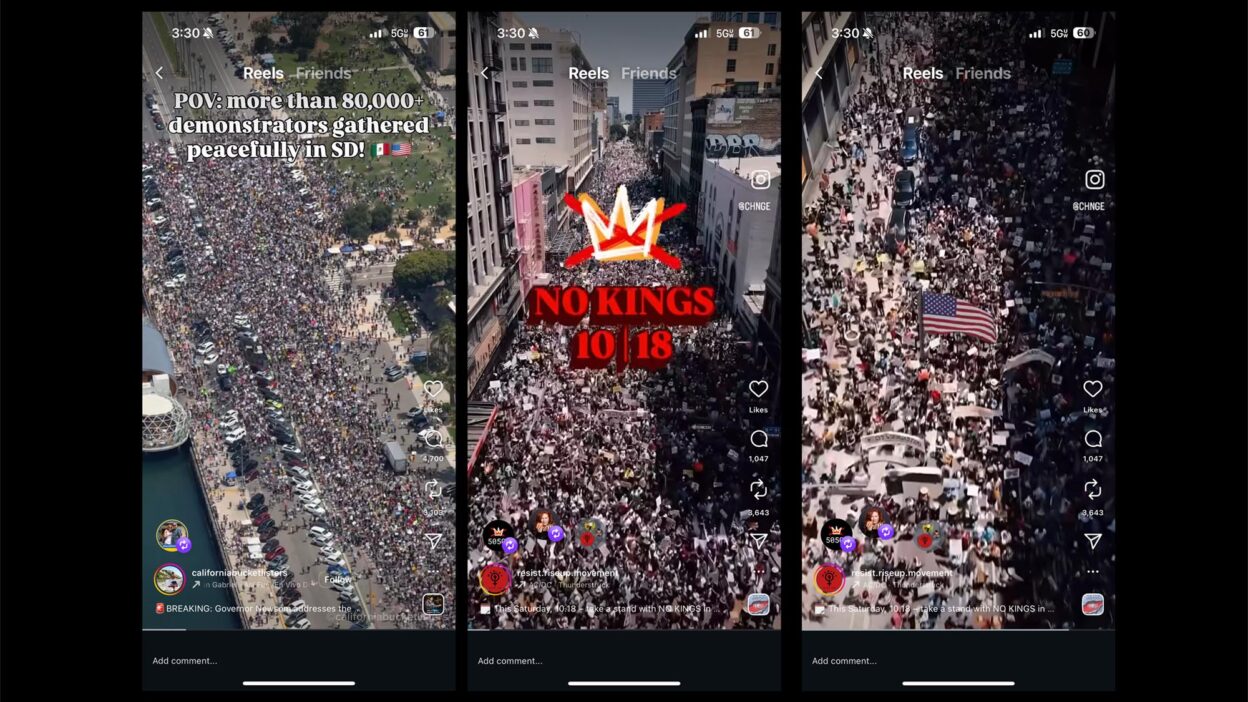In the middle of the afternoon, I caught myself just watching—grateful, awed—by what the folks behind the No Kings protests had pulled off. By nightfall, reports said that more than seven million people had marched across the country. Seven million.
That they’ve managed to do this twice is extraordinary. Most of the people who made it happen will never be known. They’ll go unnamed, unthanked, and that’s fine with them—their mission has always been to bring awareness to the seriousness of this moment. They deserve every ounce of credit.
But this isn’t really about them.
It’s about us.
⸻
When the Revolution Looks Like a New Year’s Eve Broadcast
As I watched the coverage, I couldn’t shake the feeling that I was watching a holiday special instead of a reckoning. Studio panels. Field correspondents running around trying to find the next person in an inflatable costume to interview for a soundbite. It was absurd.
It looked like a New Year’s Eve broadcast, just with protest signs instead of party hats.
We already know the hot take: what the so-called “king” is doing is awful. That’s not news. The question that kept nagging me was, what happens the day after tomorrow?
I believe in protest. I’ve marched. I’ve chanted until my throat hurt. But I can’t shake the image of Trump, Vance, Stephen Miller, Kristi Noem, and Tom Homan sitting somewhere in the White House, watching the footage, smirking.
Their collective response: No.
We’re watching three branches of government – spineless—unwilling or unable to act as a bulwark against what increasingly feels like a fascist takeover. Every protest brings a heavier hand. Every cry for justice meets more unqualified soldiers “keeping order.”
Thirteen people have died in ICE custody, and there’s not even a flicker of moral recognition from those responsible.
Trump’s only consistent skill has been to double down—and then triple down. So I keep asking myself: what comes next, when everyone goes home?
⸻
The Theater of Doing Something
I can already picture it: the millions who will wake up feeling proud they “did their part.” Signs in recycling bins. Social-media posts fading down the feed. By Monday, the moment’s gone.
We tell ourselves we’ve participated in the highest form of civic engagement—what now feels like activist theater.
I’m old enough to remember Kony 2012, when an entire generation went to war with an internet villain—until they forgot to keep caring. It was the birth of the slacktivist era: change your profile pic, hashtag your outrage, then move on to the next cause du jour.
You hold up a clever sign, bask in the crowd’s energy, and that becomes your “civic duty.” But when Monday comes, it’s back to email, back to errands, while real people keep suffering beneath the surface—voices drowned out by the hum of normalcy.
⸻
What the Community Actually Says
Later that day, I talked to people in immigrant communities—the ones living this nightmare every day. When I asked what they thought of the protests, the most common responses were sighs, eye-rolls, and the occasional “pendejadas.” (stupidy, nonsense, but more a bunch of crap)
They don’t need theater. They need action.
A cook I know shrugged: “That stuff doesn’t pertain to us. We just keep working and hope for the best.” Others were harsher: “Those are the actions of the entitled.”
I’ve been in rural homes where you can see the road for miles—enough warning to spot ICE before they reach the driveway. Inside those homes, children play on plastic jungle gyms that belong outside. Think about that level of fear: to keep your kids’ playsets indoors because visibility itself feels dangerous.
These families don’t get the privilege of marching. For them, survival is the protest.
⸻
Pride Merch, Protests, and Performative Morality
The No Kings marches reminded me of when Target and Starbucks rolled out their Pride lines. At first, it felt good—like recognition. And then it felt hollow.
The minute a few loud voices pushed back, the same corporations folded, shoving “allyship” back into the closet. Performative morality has a short shelf life.
It’s hard to celebrate a sign that says “The only orange you love is Otto” when the same university cuts diversity programs until students feel like ghosts.
Or when that same university pauses programs “..amid Portfolio Review” that deal with things like African-American Studies, Middle Eastern Studies, and Modern Jewish Studies.
It’s hard to rally for justice when lawyers capitulate. It’s hard to shout about truth when newsrooms keep cutting Black, Latino, and trans journalists, explaining it away as “economic.”
At some point, you start to wonder if our only recognized value is economic, not human.
⸻
The Day After Tomorrow
Still, what we achieved today was extraordinary. I’m genuinely grateful to the No Kings movement for lighting up this dark chapter in our history.
I just hope that tomorrow—and the day after tomorrow—the flame doesn’t die out. That the seven million who took to the streets carry even a spark of that energy forward.
Because movements don’t end when the chants fade. They end when conviction does.
And conviction is built one small, stubborn act at a time.
So here’s my hope: that everyone who marched on Saturday promises themselves just one thing—to do one thing a day that makes this better.
Not for the spectacle.
Not for the hashtag.
But for the people who can’t afford to wait for the next performance.
